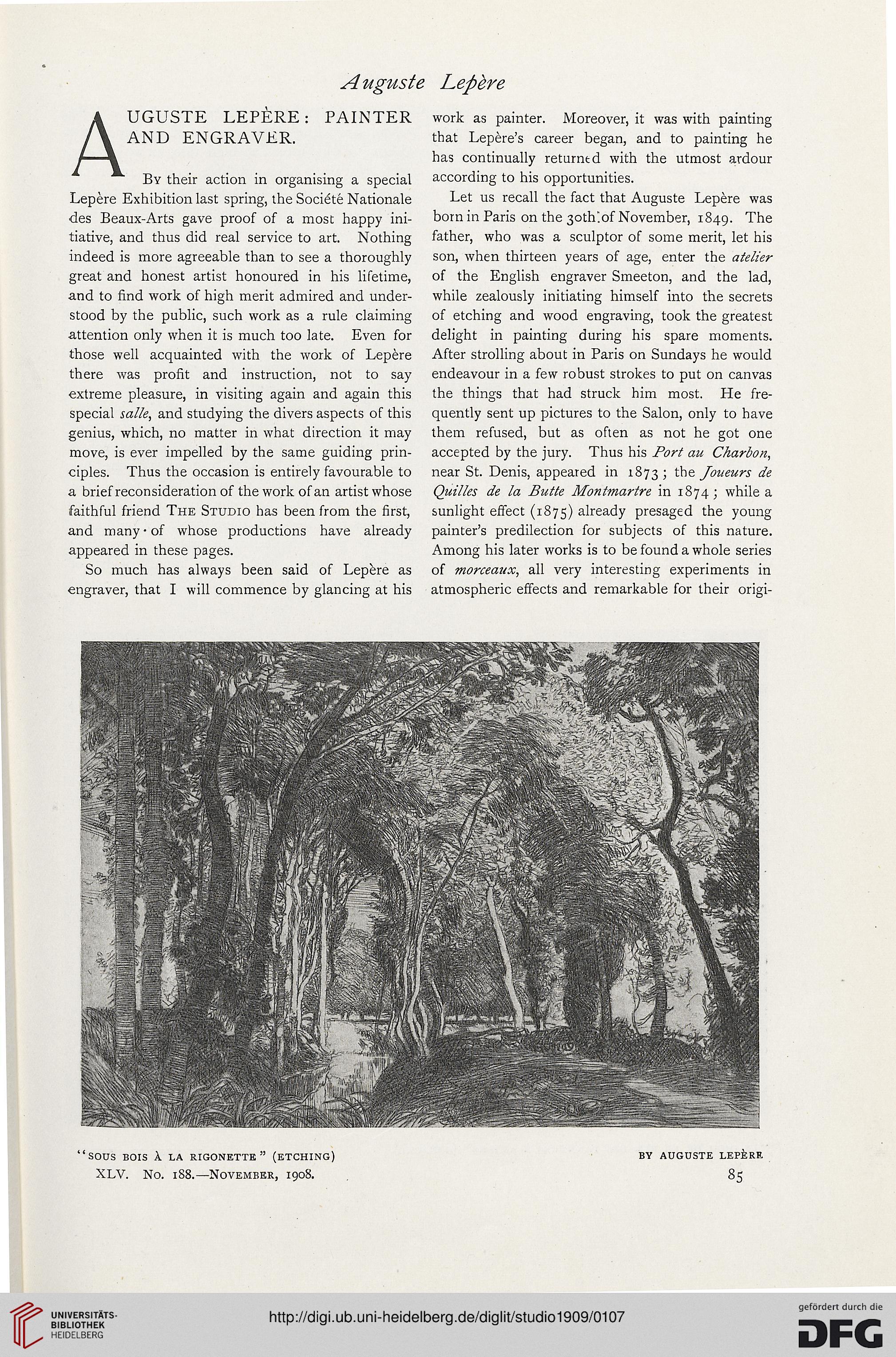A uguste
Auguste lepère: painter
AND ENGRAVER.
By their action in organising a special
Lepère Exhibition last spring, the Société Nationale
des Beaux-Arts gave proof of a most happy ini-
tiative, and thus did real service to art. Nothing
indeed is more agreeable than to see a thoroughly
great and honest artist honoured in his lifetime,
and to find work of high merit admired and under-
stood by the public, such work as a rule claiming
attention only when it is much too late. Even for
those well acquainted with the work of Lepère
there was profit and instruction, not to say
extreme pleasure, in visiting again and again this
special salle, and studying the divers aspects of this
genius, which, no matter in what direction it may
move, is ever impelled by the same guiding prin-
ciples. Thus the occasion is entirely favourable to
a brief reconsideration of the work of an artist whose
faithful friend The Studio has been from the first,
and many • of whose productions have already
appeared in these pages.
So much has always been said of Lepère as
engraver, that I will commence by glancing at his
Lepère
work as painter. Moreover, it was with painting
that Lepère’s career began, and to painting he
has continually returned with the utmost ardour
according to his opportunities.
Let us recall the fact that Auguste Lepère was
born in Paris on the ßothiof November, 1849. The
father, who was a sculptor of some merit, let his
son, when thirteen years of age, enter the atelier
of the English engraver Smeeton, and the lad,
while zealously initiating himself into the secrets
of etching and wood engraving, took the greatest
delight in painting during his spare moments.
After strolling about in Paris on Sundays he would
endeavour in a few robust strokes to put on canvas
the things that had struck him most. He fre-
quently sent up pictures to the Salon, only to have
them refused, but as often as not he got one
accepted by the jury. Thus his Port au Charbon,
near St. Denis, appeared in 1873 ; the Joueurs de
Quilles de la Butte Montmartre in 1874 ; while a
sunlight effect (1875) already presaged the young
painter’s predilection for subjects of this nature.
Among his later works is to be found a whole series
of morceaux, all very interesting experiments in
atmospheric effects and remarkable for their origi-
Auguste lepère: painter
AND ENGRAVER.
By their action in organising a special
Lepère Exhibition last spring, the Société Nationale
des Beaux-Arts gave proof of a most happy ini-
tiative, and thus did real service to art. Nothing
indeed is more agreeable than to see a thoroughly
great and honest artist honoured in his lifetime,
and to find work of high merit admired and under-
stood by the public, such work as a rule claiming
attention only when it is much too late. Even for
those well acquainted with the work of Lepère
there was profit and instruction, not to say
extreme pleasure, in visiting again and again this
special salle, and studying the divers aspects of this
genius, which, no matter in what direction it may
move, is ever impelled by the same guiding prin-
ciples. Thus the occasion is entirely favourable to
a brief reconsideration of the work of an artist whose
faithful friend The Studio has been from the first,
and many • of whose productions have already
appeared in these pages.
So much has always been said of Lepère as
engraver, that I will commence by glancing at his
Lepère
work as painter. Moreover, it was with painting
that Lepère’s career began, and to painting he
has continually returned with the utmost ardour
according to his opportunities.
Let us recall the fact that Auguste Lepère was
born in Paris on the ßothiof November, 1849. The
father, who was a sculptor of some merit, let his
son, when thirteen years of age, enter the atelier
of the English engraver Smeeton, and the lad,
while zealously initiating himself into the secrets
of etching and wood engraving, took the greatest
delight in painting during his spare moments.
After strolling about in Paris on Sundays he would
endeavour in a few robust strokes to put on canvas
the things that had struck him most. He fre-
quently sent up pictures to the Salon, only to have
them refused, but as often as not he got one
accepted by the jury. Thus his Port au Charbon,
near St. Denis, appeared in 1873 ; the Joueurs de
Quilles de la Butte Montmartre in 1874 ; while a
sunlight effect (1875) already presaged the young
painter’s predilection for subjects of this nature.
Among his later works is to be found a whole series
of morceaux, all very interesting experiments in
atmospheric effects and remarkable for their origi-




